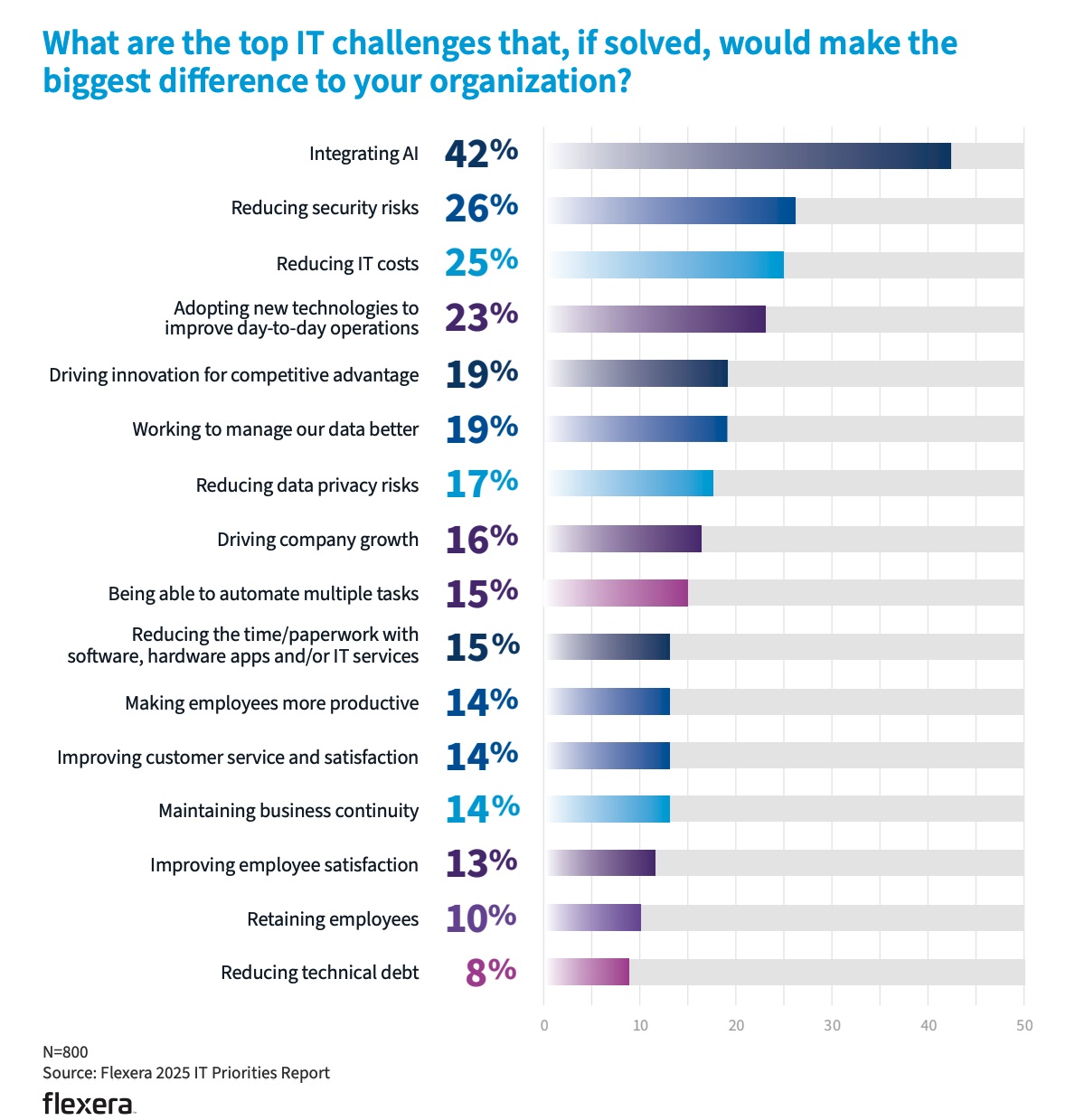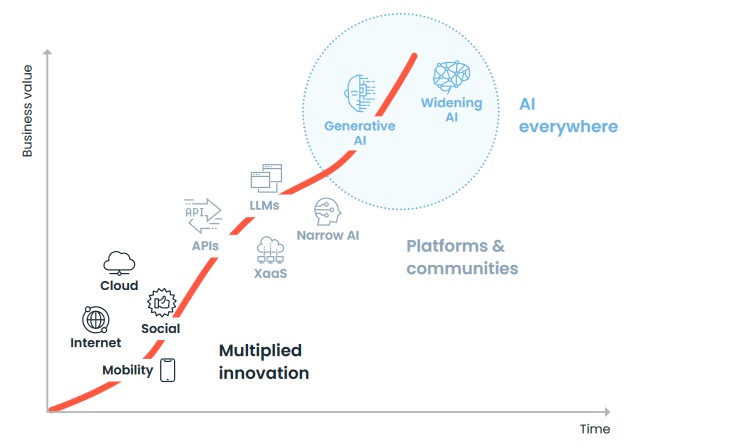As organizations prepare for 2025, IT professionals are responding to fast-moving changes in the industry. The Flexera 2025 IT Priorities Report highlights key trends dominating IT strategies, drawing on a survey of 800 IT leaders at companies of all sizes and across industries.
From the accelerating adoption of artificial intelligence (AI) and generative AI (GenAI) to the ongoing challenges of cost optimization and security, these IT leaders are navigating a complex and rapidly evolving landscape. Here's what you should know about the top priorities shaping the year ahead.
AI Integration Dominates IT Agenda
Artificial intelligence continues to be the centerpiece of IT strategies. The data underscores this enthusiasm: 74% of leaders anticipate using more AI in the next two to three years. The prevalence of AI initiatives is also driving efforts to implement it effectively: for the second consecutive year, "integrating AI" has emerged as the top priority, with 46% of IT leaders citing it as their primary focus for the next year — an 11-point increase from last year.
Despite the energy, IT teams face challenges demonstrating tangible returns on AI investments. While 85% of leaders report being prepared to leverage generative AI, 90% acknowledge that workforce skill sets need to evolve to fully capitalize on this technology. This tension between readiness and capability underscores the importance of balancing technical integration with human expertise.
Additionally, as organizations move beyond pilot initiatives and proof of concept projects, they're evaluating how to measure the success of AI, as traditional metrics (including revenue growth and cost reduction) may not fully reflect its impact.
Key Takeaways:
■ 46% of IT leaders prioritize AI integration, up from 35% last year.
■ 74% expect increased AI usage in the next few years.
■ Demonstrating concrete ROI from AI initiatives will be critical in 2025.

Cost Optimization Pressures
Cost management remains a significant concern for IT leaders. More than a quarter (27%) identify "reducing IT costs" as a top IT priority for the coming year. This is necessary because technology overspending persists despite widespread cost-cutting measures, particularly in cloud services. The report reveals an average overspend of 22% on infrastructure-as-a-service (IaaS) and platform-as-a-service (PaaS).
Security tools top the list of overspending categories, with 31% of leaders identifying them as their primary area of waste. Cloud services (PaaS) and SaaS applications were each reported by 26% as the top area of overspending.
Cloud costs are a particular pain point, with 71% of respondents stating that these expenses weigh heavily on their budgets. However, many organizations have yet to implement robust cost optimization practices like FinOps, leaving room for improvement in managing expenditures.
These FinOps processes can save money well beyond the cloud. For example, the FinOps Foundation recently published The Scope of FinOps Extends Beyond Public Cloud, outlining how organizations are increasingly extending FinOps beyond cloud computing to include SaaS and Data Center software.
Key Takeaways:
■ 27% of IT leaders prioritize reducing costs, yet overspending remains high.
■ Security tools and cloud services are the most significant areas of financial waste.
■ 71% of IT leaders feel burdened by cloud costs.
Cloud and Infrastructure Evolution
Investments in cloud infrastructure and services continue to grow, reflecting their centrality to modern IT operations. In the past year, 69% of IT leaders increased their investment in IaaS, and 66% boosted spending on PaaS.
Managing these hybrid environments remains a challenge. Many organizations need help to unify monitoring and optimization across on-premises and cloud infrastructures.
As AI adoption accelerates, the demand for cloud resources will only intensify. IT leaders must find ways to balance performance, scalability, and cost-effectiveness to sustain growth.
Key Takeaways:
■ 69% of leaders increased investments in cloud infrastructure last year.
■ 66% increased investments in PaaS last year.
■ 64% of leaders increased investments in SaaS infrastructure.
■ 57% of leaders increased investments in on-premises or private cloud infrastructure.
Security and Performance Balance
The rising cost of data breaches has made reducing security risks a priority for 25% of IT leaders, while spending on security continues to rise. With the average cost of a data breach up 10% this year to $4.88 million, the stakes are high, according to IBM. Yet, improving security requires careful balancing to avoid compromising application performance. Security tools are often a source of overspending, further complicating the equation.
IT leaders seek to implement robust security measures without sacrificing efficiency or affordability. This balancing act will define many strategies in the coming year, particularly as organizations face growing cyber threats and compliance requirements.
Key Takeaways:
■ 25% of IT leaders prioritize reducing security risks.
■ Security tools are the top area of overspending (31%).
Integrate, Manage, and Optimize
The year 2025 promises to be transformative for IT leaders as they navigate the challenges of integrating AI, managing costs, and optimizing security. The trends outlined in the report emphasize the need for strategic investments in tools and practices that drive measurable outcomes.
Organizations can turn challenges into opportunities by aligning solutions with these emerging needs, and staying competitive in an ever-evolving IT landscape. With a focus on measurable outcomes, IT leaders will be poised to make 2025 a year of innovation and success.





